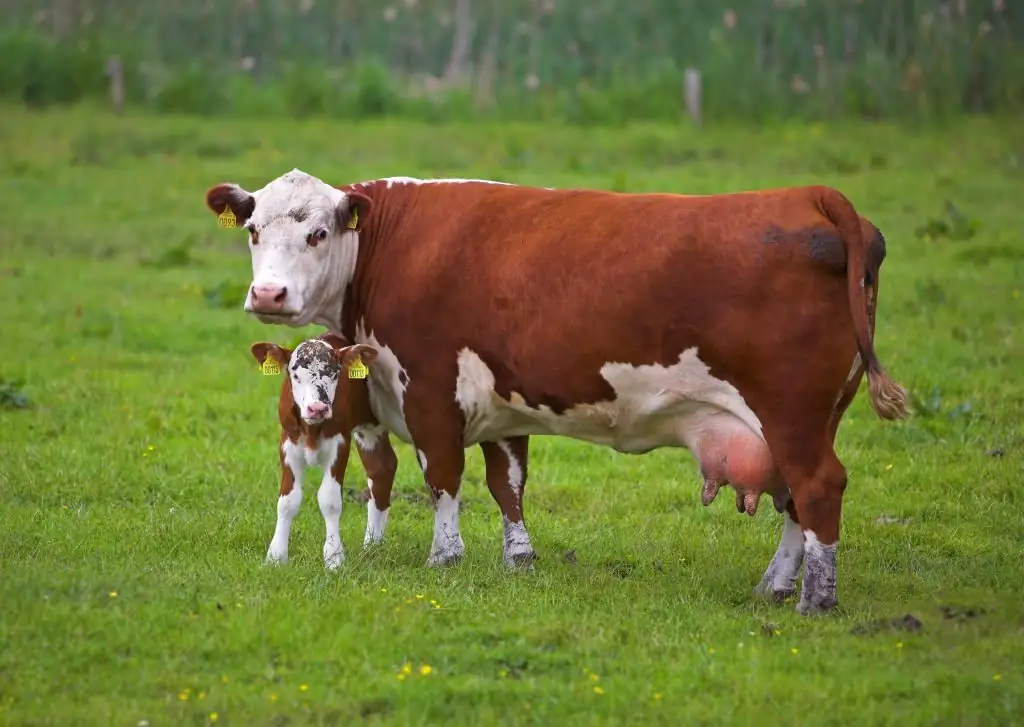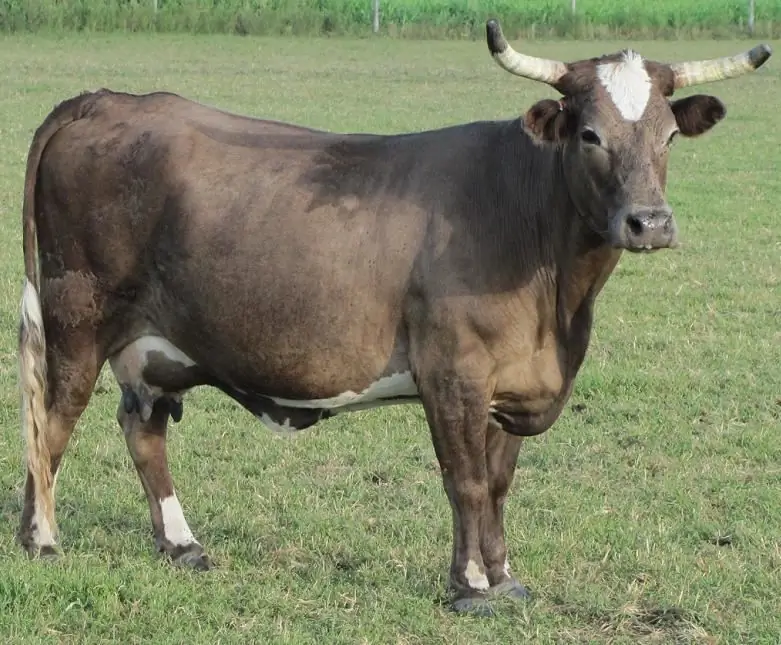2026 Author: Howard Calhoun | [email protected]. Last modified: 2025-01-24 13:10:47
Cattle trichomoniasis can cause huge material damage to the farm, because it affects the sexual function of the herd. Several types of pathogens lead to the disease, some of them are found in cows and pigs, others in humans. The main problem is that even after treatment of cattle trichomoniasis, some individuals will not be able to give birth, that is, they remain barren forever.
Pathogen causing disease
The disease occurs due to the entry of Trichomonas into the animal's body. They can be pear-shaped, oval and spindle-shaped. The size of the pathogen varies from 8 to 30 µm in length and from 3 to 15 µm in width. Trichomonas has 4 flagella on its body, with their help it moves. The pathogen parasitizes on the genital organs of cattle.
For the first time, Trichomonas in cows was discovered by a scientist named Künstler in 1888. In Russia, the causative agent of the disease became known in 1935, after it was detected in a bull by doctors Panin and Rumyantsev.
Trichomonas breedmethod of longitudinal division of the mother cell into two daughter cells. They feed endosmotically, that is, they absorb substances from the entire surface of the body. Pathogens settle in the uterus of a cow, on the penis of a bull and in other tissues of the genital organs.
Trichomonas reach their maximum size when they are in a favorable microclimate. If treatment is started in a timely manner, then the flagella of the pathogen fall off, and it dies.

Description of disease
Cattle trichomoniasis is caused by a parasite of the flagellate class. Now this disease on farms is much less common than before. This is due to the spread of artificial insemination technology, in which the disease is not transmitted. The main cause of trichomoniasis in cows is sexual intercourse with an infected bull. Sometimes entire herds are infected in this way.
If the cow was pregnant at the time of infection, she will soon throw off the calf. Most often this occurs within 1 to 4 months. Trichomoniasis leads to infertility and miscarriages. If animals are not valuable in terms of reproduction, then they are most often handed over to butchers, only promising ones are treated.
Which regions are most affected by the disease?
Trichomoniasis in cattle is registered in many countries. The disease is common in Russia, Ukraine, Belarus, Kazakhstan. Very often, trichomoniasis in cows is diagnosed in the Caucasian republics. There is a disease in the countries of Europe, Asia, Africa, America.
The most favorable regions for the development of the disease are regions with warm mildclimate. Therefore, in Russia, trichomoniasis in cattle is more common in the south. Under favorable climate conditions, the causative agent of the disease can remain viable in feces or urine for 2-3 weeks.

Do cattle have immunity to trichomoniasis?
People have long been trying to breed cows that will be resistant to various diseases. For example, Krasnogorbatov cattle is practically not susceptible to leukemia and brucellosis. In the case of cattle trichomoniasis, it was not possible to breed such breeds.
However, it has been proven that some of the animals who recovered from the disease received immunity. Also, some animals are less susceptible to trichomoniasis than others. Perhaps this is due to their strong natural immunity. Scientists have been trying for many years to create a vaccine against trichomoniasis, but so far their attempts have been unsuccessful.
Incubation period for disease development
The duration of the asymptomatic course of the disease often depends on the immunity of cattle. Trichomoniasis in cows can appear several hours after infection, this usually occurs in weakened, emaciated animals. In young and he althy individuals, the incubation period lasts about a week. In some cases, the disease is asymptomatic for 14-23 days.

Distribution routes
The disease (trichomoniasis) of cattle is most often transmitted sexually, that is, from a bull to a cow and vice versa. Mostly animals of breeding age are sick, but sometimes young animals can also become infected from them. Most often, infection occurs duringnatural mating. Very rarely, infection occurs during artificial insemination. Usually the reason for this is the use of untested semen and poor disinfection of instruments.
Another way of infection is household. Infected individuals can live with he althy animals. The transmission of trichomoniasis to cattle in this case occurs through bedding, contaminated equipment, urine and feces. The carriers of the infection can be flies, in whose body the virus can persist for up to 8 hours.
Symptoms
Sometimes the first symptoms of bovine trichomoniasis can appear within a few hours after coating. The animal becomes reluctant to eat, its temperature rises above 40°C. The cow may experience rapid breathing, increased heart rate. The animal begins to drink more.
Trichomoniasis can have two variants of the course of the disease: acute and chronic. In the first case, the symptoms in cattle are pronounced, but after 3-4 weeks they begin to fade. The owner may think that the animal has recovered, but this is not so, the disease has simply become chronic. Without treatment, the entire herd of cows will have sexual problems.
Sometimes entire farms of infected animals are found. The disease in them passes in a chronic form with virtually no symptoms. In such a herd there are always a lot of barren cows, and bulls show low sexual productivity. Animals have low milk yields, miscarriages and failed inseminations are common.

How does the disease manifest itself in cows?
In cows, the manifestations of bovine trichomoniasis are almost always moremore pronounced than in bulls. In infected cows, the walls of the vagina become inflamed and look red and swollen. Against the background of the disease in dairy animals, milk productivity always decreases. At the vault of the vagina, small neoplasms are formed, no larger than a pea. On palpation, the genitals are painful and rough. Purulent exudate may separate.
Sick cows are not covered. If the animal is already pregnant, then a miscarriage occurs within a few months. Often, an infected individual develops pyometra, a purulent inflammation of the uterus.
How does the disease progress in bulls?
In the male half of the herd, the disease is often asymptomatic. But in bulls, potency always decreases, the quality of sperm deteriorates, and the percentage of successful fertilizations decreases. If the disease proceeds in an acute form, then the manufacturer develops swelling of the penis, purulent and mucous secretions may appear. The prepuce area looks contaminated. Nodules of bright red or gray color are found on the mucous membrane of the penis. The bull may begin to have problems with urination, this process becomes painful for him.
About a month later, all the symptoms of the animal disappear, the disease becomes chronic. However, rectal examination often reveals changes in the prostate gland. The bull is not cured, he continues to infect the herd.

Diagnosis
If trichomoniasis is suspected, the owner of the animal should call a veterinarian, and not deal withself-medication. To establish an accurate diagnosis, the doctor takes swabs from the genitals of animals, sperm, mucus from the vagina, scrapings from the prepuce. The resulting material is sown on nutrient media. This method is the main one in the diagnosis of bovine trichomoniasis.
Also examine aborted fetuses up to 3-4 months of pregnancy. They are taken to the laboratory along with the placenta and all membranes. But in order for the diagnosis to be made correctly, the fetus must get to the specialists no later than 12 hours after the abortion.
Treatment
Complex treatment is used to get rid of trichomoniasis. Like people, cows need to work in 2 directions: destroy pathogenic microflora and improve the genitals. To reduce the uterus and quickly remove inflamed contents from it, doctors prescribe drugs such as Oxytocin, Prozerin, Pituitrin. Irrigation with "Furacillin", "Ammargen", "Chinozol" is also often prescribed. Of the antibiotics, Trichomonocide proved to be the best.
Bulls treat the penis with ichthyol ointment, moisten with hydrogen peroxide or chlorhexidine. An excellent result is given by injections of the drug "Trichopol". After treatment, animals are checked for trichomoniasis after 7-10 days.

Prevention
To reduce the incidence of livestock on the farm, you need to start using artificial insemination with the sperm of the examined bulls. This measure is the best prevention of trichomoniasis in cattle. If a cow is covered by a bull in a natural way, then he can infect her with a massdiseases. Artificial insemination should be carried out by a trained specialist. During the procedure, all veterinary and sanitary rules must be observed.
If new animals were brought to the farm, they must be placed in a separate room. Before launching into the main herd, they need to be examined and tested for trichomoniasis and other diseases. You should not allow your animals to communicate with other people's unexamined individuals. If infection could not be avoided, then the cattle is quarantined for the duration of treatment.
Danger to humans
Veterinarians say that trichomoniasis from livestock cannot be transmitted to humans. The thing is that although in fact this is one disease, but it is caused by different pathogens. Trichomonas foetus is dangerous for animals, and vaginalis is dangerous for humans. It is for these reasons that it is impossible to become infected when communicating with livestock. But in any case, it is necessary to observe hygiene standards when caring for animals.
Trichomonosis is not transmitted through cow's milk, meat and offal. But before killing and after slaughter, the cattle must be inspected. If the veterinarian notices purulent discharge, endometritis or vaginitis, then the animal is tested posthumously. When the diagnosis is confirmed, all affected organs and tissues are removed for disposal.

Vet advice
Experts recommend careful selection of livestock. You can buy cows only in prosperous farms. The animal must be quarantined upon arrival at a new home. Better if the cow stands aloneabout a month.
For any doubtful discharge from the genital tract, you need to call a veterinarian. If trichomoniasis was detected during the diagnosis, then you should not delay the treatment. This disease is very insidious and can bring enormous financial losses to the household.
Recommended:
Cattle fascioliasis: causes, symptoms, diagnosis, treatment and prevention

Cattle fascioliasis is a disease that can bring great material damage to the farm. In an infected cow, milk yield drops, weight decreases, and reproductive function is impaired. To protect livestock, it is necessary to carry out anthelmintic treatment in a timely manner and carefully approach the choice of pastures
Cattle piroplasmosis: etiology, causes and signs, symptoms and treatment of cattle

Most often, outbreaks of piroplasmosis are recorded in the spring-autumn season. Cows go out to pastures where they encounter infected ticks. The disease is transmitted through the bite of a parasite and can cause a decrease in herd productivity. In some cases, the death of livestock occurs. To prevent economic losses, it is necessary to carry out preventive measures
Cattle viral diarrhea: symptoms, causes, veterinary advice on treatment and prevention

Bovine viral diarrhea mainly affects calves under the age of 5 months, and mortality in some farms is 90% of the total livestock. Several factors increase the likelihood of infection, so owners need to be very careful when caring for their livestock
Newcastle disease in poultry: causes, symptoms, diagnosis, treatment and prevention

Today, livestock farmers have faced a huge number of different ailments. Many of them can be cured with effective drugs, but there are those that are exclusively fatal. Newcastle disease is a viral disease that mainly affects birds
Hypodermatosis in cattle: causes, symptoms, diagnosis and treatment

Cattle hypodermatosis is a dangerous disease that leads to loss of animal productivity. This disease is caused by larvae of subcutaneous gadflies of two varieties. At a late stage of development, nodules form on the body of cows with hypodermatosis. This disease is contagious, so sick animals should be treated as soon as possible

